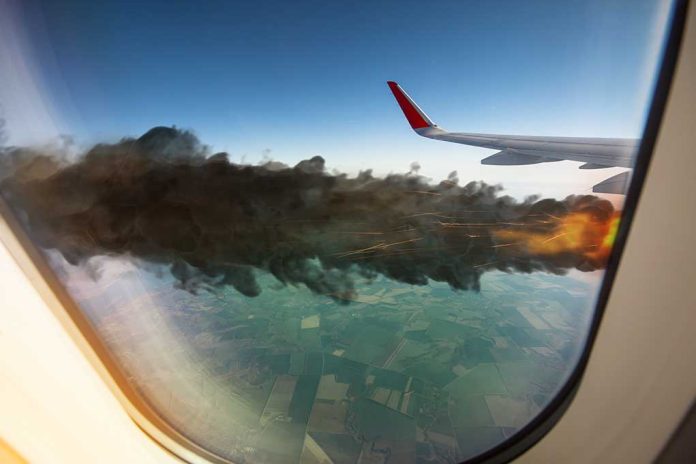🔴 Website 👉 https://u-s-news.com/
Telegram 👉 https://t.me/usnewscom_channel
Panic erupted on a Southwest Airlines flight as a passenger’s smartphone burst into flames, forcing an emergency evacuation and highlighting the ongoing dangers of lithium-ion batteries in air travel.
At a Glance
- A smartphone battery caught fire on Southwest Airlines Flight 3316 at Denver International Airport
- Over 100 passengers evacuated via jet bridge and emergency slides
- Two passengers were injured, including the phone’s owner who suffered burns
- The incident underscores the risks of lithium-ion batteries on flights
- FAA is investigating, raising questions about current safety protocols
Smartphone Ignites Chaos on Southwest Flight
In a harrowing incident that exposes the vulnerabilities in our high-tech, battery-dependent world, passengers on Southwest Airlines Flight 3316 found themselves in a nightmare scenario. As the Houston-bound flight prepared for takeoff at Denver International Airport, a passenger’s smartphone suddenly erupted in flames, filling the cabin with smoke and triggering an immediate evacuation.
The swift action of the crew prevented a potential disaster, but the incident has reignited concerns about the safety of lithium-ion batteries on aircraft. This event serves as a stark reminder of the hidden dangers lurking in the everyday devices we carry, and raises questions about the adequacy of current safety measures.
A Southwest airplane was struck by gunfire near the cockpit, while preparing for departure from Dallas Love Field Airport.
On another Southwest flight departing from Denver, a cell phone battery ignited, forcing all passengers to evacuate. Two injuries were reported. pic.twitter.com/kNNK3Ga48H
— ABC News Live (@ABCNewsLive) November 16, 2024
Evacuation Drama Unfolds
As smoke billowed through the cabin, panic set in among the 108 passengers. The crew’s quick thinking and passengers’ compliance with evacuation procedures prevented a potentially catastrophic outcome. Some passengers exited via the jet bridge, while others were forced to use the emergency slides, creating a scene of controlled chaos.
“Everybody saw the smoke, because it kind of filled the back of the cabin, And then somebody screamed ‘Fire.’” – Jennifer Rodgers
The incident resulted in minor injuries to two passengers, including burns to the unfortunate owner of the combustible smartphone. This real-life drama underscores the importance of passenger awareness and crew preparedness in handling unexpected emergencies.
The Lithium-Ion Dilemma
The Federal Aviation Administration (FAA) is now investigating this alarming incident, which is far from an isolated occurrence. FAA data reveals that incidents involving lithium-ion batteries on airplanes happen more than once a week in the United States alone. This frequency is a clear indication that current safety measures may be insufficient to address this growing threat.
“A Southwest spokesperson said the plane was still at the gate when the fire started before 7 a.m. as it prepared to take off for Houston.” – Southwest spokesperson
While airlines have implemented restrictions on power banks and require them to be carried in cabin luggage, this incident proves that these measures alone are not foolproof. The conservative approach would be to reevaluate and potentially tighten regulations surrounding the transport of lithium-ion batteries on aircraft.
A Call for Heightened Vigilance
This incident should serve as a wake-up call for both the airline industry and passengers. While modern technology has undoubtedly improved our lives, it also brings new risks that must be managed. As conservatives, we must advocate for responsible use of technology and stricter safety protocols to protect American lives.
The FAA and airlines must work together to develop more robust screening procedures and safety measures to prevent such incidents. Passengers, too, must be educated about the potential dangers of their devices and how to properly handle them during air travel.
As we await the results of the FAA investigation, one thing is clear: the safety of American air travelers must be paramount. It’s time for a serious discussion about the risks we’re willing to accept in the name of convenience and how we can better safeguard our skies from the hidden dangers of modern technology.

